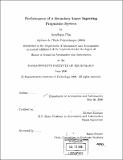| dc.contributor.advisor | Edward Greitzer. | en_US |
| dc.contributor.author | Plas, Angélique (Angélique Pascale) | en_US |
| dc.contributor.other | Massachusetts Institute of Technology. Dept. of Aeronautics and Astronautics. | en_US |
| dc.date.accessioned | 2007-01-10T16:40:08Z | |
| dc.date.available | 2007-01-10T16:40:08Z | |
| dc.date.copyright | 2006 | en_US |
| dc.date.issued | 2006 | en_US |
| dc.identifier.uri | http://hdl.handle.net/1721.1/35568 | |
| dc.description | Thesis (S.M.)--Massachusetts Institute of Technology, Dept. of Aeronautics and Astronautics, 2006. | en_US |
| dc.description | Includes bibliographical references (p. 111-114). | en_US |
| dc.description.abstract | This thesis presents an assessment of the aerodynamic performance of an aircraft propulsion system, with embedded engines, in the presence of aircraft fuselage boundary layer ingestion (BLI). The emphasis is on defining the role that the turbomachinery (i.e., the fan, in the ultra high bypass engines considered) plays in establishing the flow benefit due to BLI. A three-dimensional body force approach to fan response to inlet distortion has been utilized to analyze the flow in the engine ducts. In addition to providing quantitative information as to the fuel burn benefit from BLI, the body force approach is also compared with two simpler analyses, one based on the parallel compressor concept and one based on integral boundary layer methodology. It is shown that the distortion transfer across the fan, basically attenuation of the stagnation pressure non-uniformity downstream of the fan compared to that upstream of the fan plays a major role in determining the impact of boundary layer ingestion on fuel burn. This, in turn, puts requirements on the fidelity with which one needs to assess the distortion transfer, and thus the type of models to be used in such assessment. | en_US |
| dc.description.abstract | (cont.) In terms of qualitative information, the three models are found to give broadly similar trends for distortion attenuation and for fuel burn benefit. In terms of quantitative results, the body force analysis shows that for a fan diameter and flight condition representative of that employed in the Cambridge-MIT Institute "Silent Aircraft" boundary layer ingestion can provide decreases in fuel burn of up to 3.8 percent. | en_US |
| dc.description.statementofresponsibility | by Angélique Plas. | en_US |
| dc.format.extent | 114 p. | en_US |
| dc.format.extent | 4673689 bytes | |
| dc.format.extent | 4961486 bytes | |
| dc.format.mimetype | application/pdf | |
| dc.format.mimetype | application/pdf | |
| dc.language.iso | eng | en_US |
| dc.publisher | Massachusetts Institute of Technology | en_US |
| dc.rights | M.I.T. theses are protected by copyright. They may be viewed from this source for any purpose, but reproduction or distribution in any format is prohibited without written permission. See provided URL for inquiries about permission. | en_US |
| dc.rights.uri | http://dspace.mit.edu/handle/1721.1/7582 | |
| dc.subject | Aeronautics and Astronautics. | en_US |
| dc.title | Performance of a boundary layer ingesting propulsion system | en_US |
| dc.type | Thesis | en_US |
| dc.description.degree | S.M. | en_US |
| dc.contributor.department | Massachusetts Institute of Technology. Department of Aeronautics and Astronautics | |
| dc.identifier.oclc | 74277584 | en_US |
